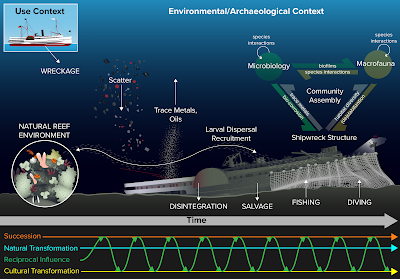Maritime Heritage Ecology
Friends, I am proud to introduce you to a new term: Maritime Heritage Ecology.
This phrase refers to the fusion of biology and archaeology that is necessary for understanding the processes that shape underwater cultural heritage. As many of you know, I've studied shipwrecks since my PhD. They're island-like systems that aren't supposed to exist, so they present a number of extremely interesting biological questions. But shipwrecks aren't just habitats - they're also historical and cultural resources. They undergo their own transformations, as wood degrades, fishing gear gets entangled, artifacts get scattered, and metal corrodes. Shipwrecks are incredibly dynamic.
Moreover, shipwrecks are not the only type of cultural heritage that lands in the ocean. There are cars, planes, and tanks. There are structures like lighthouses, wharfs, ancient villages, and middens. There are artifacts like amphoras, statues, and weapons. All of them tell the story of human interactions with the sea and host unique biological communities at the same time.
It was sometime last year when my collaborator, Calvin, and I had the same realization almost simultaneously: biologists don't understand archaeology, and archaeologists don't understand biology. In fact, the only reason Calvin and I are able to work together effectively is because we've spent the last 3 years teaching each other our fields. We wanted to offer what we've developed to others. So we wrote a paper.
I'm incredibly proud of our work. This paper marries our biological and archaeological perspectives into a seamless framework for interdisciplinary research. We described the processes occurring at maritime heritage sites and proposed a vocabulary that our colleagues could use to describe them. It is my hope that this paper will launch interdisciplinary collaborations across the world. There's a new field of study, friends: Maritime Heritage Ecology.
Find our paper in the journal Trends in Ecology and Evolution: https://doi.org/10.1016/j.tree.2022.06.014
 |
| This illustration shows the key processes in Maritime Heritage Ecology. Thanks to Natalie Renier for her incredible graphic design! |
Comments
Post a Comment